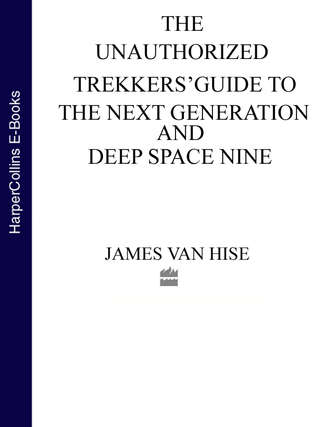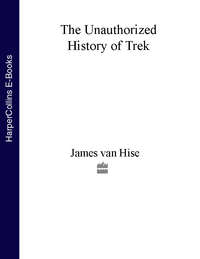
Полная версия
The Unauthorized Trekkers’ Guide to the Next Generation and Deep Space Nine
She is concerned with the plight of our nation’s homeless and has, with Robin Williams and Billy Crystal, been a prime force behind the annual Comic Relief benefit concerts. In 1989, her various charity projects resulted in her being named the Starlight Foundation’s Humanitarian of the Year.
Still active on stage, Goldberg has performed in Moms, The Spook Show, and Living on the Edge of Chaos, as well as returning to the San Diego Repertory Theater, a.k.a. The Rep, to take part in fund-raising performances (along with Patrick Stewart) for that organization.
Goldberg continued to reveal new aspects of Guinan in The Next Generation, but, as always, each new revelation only raised more questions than it answered—and that’s the way Whoopi Goldberg likes it.
CHAPTER
3
THE NEXT GENERATION OVERVIEW
In 1987 something controversial was done. Star Trek was brought back to weekly television, as Star Trek: The Next Generation, without any of the familiar faces who had graced the name since 1966. Now, seven years later, it has graduated to the big screen, but how did this series fare in quality over those seven years?
SEASON ONE
During the first year of The Next Generation, Gene Roddenberry was asked what he thought of the scripts for the show, and if he felt it was really working out. The creator of the show replied, “We got some good writing in the old series, and we’ve had some good writing in the new series. Most of the writing comes from a very few, very good people who labor hard, and very often they are staff people.”
May of 1988 saw the broadcast of the final original episode of the first year of Star Trek: The Next Generation. While it went into reruns and fans caught up with episodes they had missed, it was possible to sit back and look at all twenty-five stories and see how they shaped up. One could determine what patterns could be seen which perhaps weren’t apparent at the time an episode first aired and judge just how the year of stories held up.
While an average TV series sets up a premise and repeats it week after week, with little variation in character or structure, ST: TNG was not your average show. With an ensemble cast, on a superficial level it could be compared with shows like Hill Street Blues, St. Elsewhere, or L.A. Law, where we could see many characters vying for attention as the series sought to achieve balance. Early on it seemed that while all the characters were getting some attention, it didn’t always hold together, as though they needed a focal point. This was finally achieved when Picard and Riker emerged as the main characters, filling out enough so that shows spotlighted them, sometimes to the virtual exclusion of the other cast members (such as in the first year’s “11001001”).
THE GROWTH OF THE NEXT GENERATION
This series surpassed the original Star Trek in the sheer number of episodes, and shows an evolution much different from that found in the Star Trek of the sixties. While the first season of the original show is considered the best, with the second a close second and the third a distant third, the opposite has occurred in Star Trek: The Next Generation. This series has had growing pains, but grew appreciably better each season.
However, things got off to a rocky start.
The series started off with episodes that were often fair to mediocre, until by the end of the first year, it felt as if one had reexperienced the third season of the old Star Trek, when the episodes lurched around in strange directions as though searching for a focal point. Amid the chaos, the first season of ST: TNG did manage to produce a handful of gems out of the otherwise undistinguished first cluster. At the time many fans refused to acknowledge this and vociferously defended the new series, but looking back now from the point of view of a hundred and seventy-eight episodes, the weakness of the writing for most of the first year is quite apparent.
ENCOUNTER AT FARPOINT
The series was launched with the two-hour story “Encounter at Farpoint.” Originally written by D. C. Fontana, it was rewritten by Roddenberry and expanded to include the character of Q. This is apparent simply from the internal structure of the episode as there are two parallel stories which are forced to touch at only one point. Q was obviously a character Roddenberry liked very much, but the sad fact is that this omnipotent alien, who was a virtual clone of Trelane, the “child” being in the original Star Trek episode “Squire of Gothos,” didn’t work and wasn’t written well at all until his third outing, in the second-season episode “Q Who?,” which also introduced the Borg.
Launching the series with a much ballyhooed two-hour adventure was a good idea. Unfortunately the script wasn’t entirely up to the challenge. The story careened back and forth between two virtually unrelated plotlines—the intervention of the obnoxious, self-important Q and the mystery at Farpoint Station. When I later learned that Fontana had written a script dealing with the Farpoint mystery and Roddenberry added the Q storyline himself and forced them together, I could see why I felt as I did when watching it. The story tried hard to introduce all the characters while really revealing little about them, other than Picard’s willingness to surrender in situations where Kirk would have defied the odds in an attempt to depict Picard’s more diplomatic and temperate nature.
Unfortunately, it forced a comparison that was not in Picard’s favor. The story introduced new ideas, such as families living on the Enterprise, and then demonstrated what a horrible idea that was when the ship had to perform a dangerous saucer separation to protect the families in the main vessel from threats by Q. While the ending with the interplanetary jellyfish was touching and wrought with some beautiful special effects, it seemed to be an attempt to distract us from what led up to it and leave us with a warm feeling about the show.
THE NAKED NOW
In hindsight, the early episodes of the first season show a distinct lack of direction and forethought. The second show, “The Naked Now,” is an acknowledged remake of the original Star Trek episode “The Naked Time,” in order to give the characters some dimension, unfortunately forcing a direct comparison between the two episodes: the strengths of the original story cause it to far outweigh its reworking in The Next Generation.
“The Naked Now” was written by J. Michael Bingham, from a story by John D. F. Black and J. Michael Bingham. Black worked on the original Star Trek episode “The Naked Time,” but while the original story examined hidden motives, with many of the character traits revealed having dramatic as well as tragic overtones, the sequel carried little of the original’s sense of drama. The characters in “The Naked Now” don’t act uninhibited, but simply irrational.
Some of the actors on the show, such as Jonathan Frakes, felt that it was too early to have the characters act out of character since the viewers still weren’t sure who the characters were. The point of “The Naked Time” was never to have characters act strangely but rather to have them reveal what they are really like inside and the extent of their private demons. In this way, the characters were to be broadened and deepened through a lack of inhibitions. In “The Naked Now,” they acted crazy.
A QUESTION OF HONOR
The third episode, “Code Of Honor,” has structural elements from “Amok Time” in both the climactic fight and its resolution. Using Arabian Nights-style costuming and an all-black culture is an interesting idea for the episode, particularly the matriarchal angle (which would repeat in “Angel One”), but it’s sacrificed to stage a fight that has obvious parallels with “Amok Time” in the resolution as the one who dies is revived aboard the Enterprise.
Picard makes a lot of angry noise over the kidnaping of his security chief, but in the end seems impotent to really accomplish anything. Why he must follow the alien culture’s bizarre protocol while they can flagrantly violate the Federation’s at will without reprisal is unclear. In this writer’s opinion, the story played like a first-draft script in need of several rewrites.
ENTER THE FERENGI
Since the Klingons are now in the Federation (just as the Organians predicted in “Errand of Mercy”), a new villain was called for, or so someone thought. The villain must be vile and despicable, but maybe a bit amusing as well. Enter the Ferengi, the midget merchants of space; capitalists of the lowest order. In “The Last Outpost” another old plot is borrowed, this time from “Arena,” when a superior alien intelligence sees the Enterprise
Конец ознакомительного фрагмента.
Текст предоставлен ООО «ЛитРес».
Прочитайте эту книгу целиком, купив полную легальную версию на ЛитРес.
Безопасно оплатить книгу можно банковской картой Visa, MasterCard, Maestro, со счета мобильного телефона, с платежного терминала, в салоне МТС или Связной, через PayPal, WebMoney, Яндекс.Деньги, QIWI Кошелек, бонусными картами или другим удобным Вам способом.



